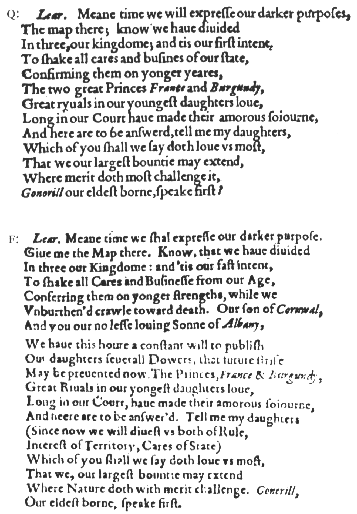
1. Sometimes we commonly assume that the text of a Shakespeare play available in a modern "book store" edition is what Shakespeare actually wrote, and what we read is what he said and meant. Not so. If you are using a scholarly edition such as the Cambridge or Arden series, you will see under the text on each page, coding labeled Q1=_____ or F1=_____ etc.
2. When this happens, you are alerted to the fact that a modern text is frequently a synthesis of various editions of the play that have come down from Shakespeare's day. The text of LEAR is a case in point. Modern editions [See the bibliography at the end of this exercise] are derived from the following based on information provided in the Cambridge Edition, where Q = a single copy of the play, and F = the collected edition of the plays published after Shakespeare's death in 1623:

3. The diagram suggests that editors must try to make a synthesis between Q1 and F1. The problem is that F1 has 285 lines less than Q1, so that F1 must have been cut. Who did this and why? F1 also has 115 lines not in Q1. The question becomes one of establishing an authoritative text.
4. This project will be to work on a section of the text to determine what is authoritative. You will assume the role of and editor and decide:
a. should you go with the F or Q or some combination?
b. does adding or cutting a passage change the plot? character development?
c. what makes the most sense in terms of the pragmatic theory of literature?
d. what do you think Shakespeare's intention was?
PROBLEM ONE:
Look at this page from the opening scene; the spelling is not modernized:
The Quarto edition is followed by the Folio edition:

Compare these excerpts from the Q and F to your edition of the play for: I,i,31-49.
Note the difference:
Q says "FIRFT INTENT" meaning 'FIRST INTENT"
F says "FAFT INTENT" meaning "FAST INTENT"
Does it make any difference; what can we conclude concerning the above questions you must keep in mind as an editor?
PROBLEM TWO:
Look at this page from II,iv,181 ff. involving Goneril's character:
This is the Quarto edition:
This is the Folio edition:
PROBLEM: What is the difference between the F and Q version, and why is the difference important?
PROBLEM THREE:
The last words in the play are spoken by Edgar (F) or Albany (Q) Is the difference important in terms of how the characters have been developed throughout the play?
PROBLEM FOUR:
At the end of the play, we have the words:
"Break heart, I pray thee."
F gives these words to Kent, and Q to Lear. What is the difference?
F1 PASSAGE ONLY (RECALL THERE ARE 115 LINES NOT IN Q THAT ARE IN F1). There are two possibilities for F1 passages only: 1) passages restored to F that were accidentally omitted from Q or 2) passages added later by a reviser deemed essential to the text:
PASSAGE ONE:
After: I,i,82, should-- "than that...fortunes" be retained or cut? This addition to the text is based on the F1 and does not appear in the Q.
PASSAGE TWO:
See I,ii,96-100. ("these late eclipses") by Gloucester, and I,ii,140-149, ("I promise you") by Edmund comparatively. In the first segment, the lines "This villaine...our graves" does appear in F. In the second passage, the lines "as of...astronomical" are in Q and not in F. What should be done? Also: at I,ii,161 ("Some villain") by Edgar and Edmund's response, the lines "I pray you...brother" are in F and not Q. Evaluate and recommend what to include or exclude.
PASSAGE THREE:
Look at III,ii,79-96 dealing with the Fool's prophecy. This passage is in F and not Q. Should it be included, and also look at the ordering of the lines themselves. Some editors who retain the passage would like to see a change in the order. Should there be, and if so to what?
PASSAGE FOUR:
Look at III,vi,84 that are reputed to be the Fool's last lines: "And I'll go to bed at noon." These lines are in F and not Q. Could these be added lines by Shakespeare? Why?
PASSAGE FIVE:
In III,vi,14-- the mock trial episode: "the foul...let her 'scape" is omitted from the F. Why?
DO THE FOLLOWING:
1. Write a character sketch of Albany based on how he behaves, and others respond to him.
2. Be very careful to note the female character evaluations.
3. This must include textual support for every major idea you advance.
1: IV, 259: " Pray, Sir, be patient" is in F and not Q
2: IV,321-32: "This man hath...unfitness" is in F and not Q
3: V,ii,31-50: Albany speaking: "O Goneril
You are not worth: "I fear...of the deep" are Q not F
4: V,I,11-29: Note the following below: what is in [...] is omitted from F:
THE FOLLOWING SOURCES WERE USED IN THE PREPARATION OF THIS EXERCISE.
HALIO, JAY, (ED.). THE TRAGEDY OF KING LEAR. THE NEW CAMBRIDGE SHAKESPEARE. CAMBRIDGE UNIVERSITY PRESS, 1992.
The exercises in this project are derived from the introductory and concluding essays in this text.
MUIR, KEN, (ED.). KING LEAR. HARPER AND ROW, BARNES AND NOBLE IMPORT DIVISION, 1978.